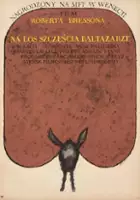Na los szczęścia, Baltazarze!
Au hasard Balthazar
1966
powrót do forum filmu Na los szczęścia, Baltazarze!
"A common reading of Balthazar, relying on an orthodox sense of Bresson’s Catholicism, on the Palm Sunday imagery of Jesus riding into Jerusalem on “the foal of a donkey,” . . . ascribes to the animal a Christlike status. In this schema, Balthazar, after enjoying a brief, paradisal childhood, apparent in the image of his nuzzling his mother’s milk that opens the film and his playful baptism by three children, lives a calvary. Passed from cruel master to cruel master, Balthazar traverses the stations of the cross, beaten, whipped, slapped, burned, mocked, and, in the concluding crucifixion, shot and abandoned to bleed to death, the hillside on which he perishes a modern-day Golgotha. That he dies literally burdened (with contraband) suggests, in this reading, a sacrifice for humanity. This meaning is intensified by Balthazar’s sole, stigmata-like wound and by the sheep that flow around him, a tide of white that surrounds his dark, prostrate form. With their tolling bells, they evoke the Agnus Dei [Lamb of God] and thereby the liturgy, “Qui tollis peccata mundi, miserere nobis [who takes away the sins of the world, have mercy on us].” Balthazar has died for the sins of those who have transgressed against him—the alcoholic Arnold, the vicious Gérard, the mean, miserly merchant—and of the few who have not, particularly the martyred Marie, whose fate parallels his.
This interpretation is tempting in its simplicity. That Balthazar passes through the hands of seven masters suggests to some a numerical trace of the seven words from the cross, the seven sacraments of the church formed by Christ’s Passion, or the seven deadly sins. The mock baptism performed by the children and the auditory equation of church bells with Balthazar’s bell indicate the animal’s divinity; Marie’s name suggests the mother of God, and the garland of flowers she makes for Balthazar is reminiscent of Christ’s crown of thorns; the strange bestiary in the circus implies the ark; the smugglers’ gold and perfume are the equivalent of the offerings of the magi; Gérard’s band of blousons noirs [black jackets] represent Christ’s tormentors (or, as Gilles Jacob has suggested, the thieves of Ecclesiastes); the wine that Arnold drinks and the bread that Gérard delivers both suggest transubstantiation; Arnold is in many ways a Judas figure; and so on."
James Quandt, "Au Hasard Balthazar", The Criterion Collection, 2005.

